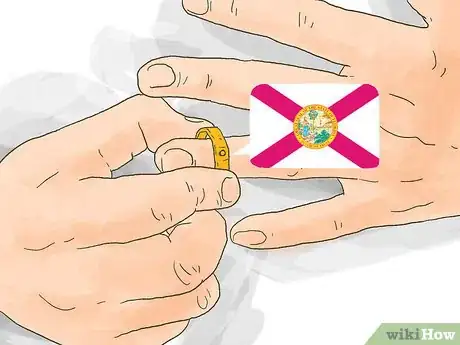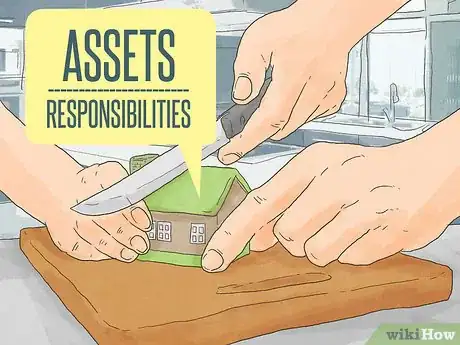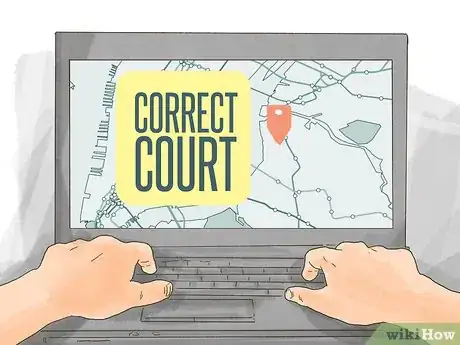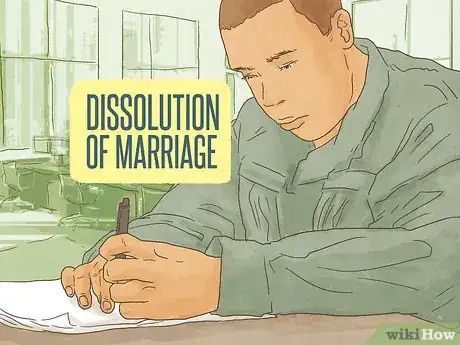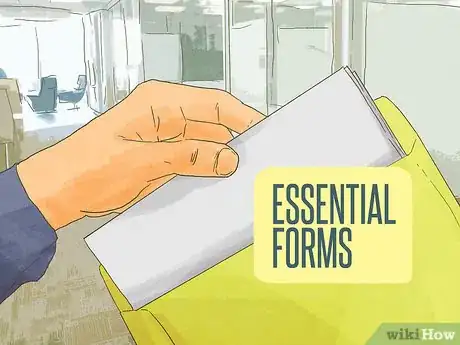This article was co-authored by Clinton M. Sandvick, JD, PhD. Clinton M. Sandvick worked as a civil litigator in California for over 7 years. He received his JD from the University of Wisconsin-Madison in 1998 and his PhD in American History from the University of Oregon in 2013.
There are 12 references cited in this article, which can be found at the bottom of the page.
This article has been viewed 61,954 times.
Under Florida law, the quickest that anyone can get divorced is 20 days.[1] Divorce in Florida is technically called “dissolution of marriage.” There are two forms: simplified divorce and regular divorce. If you have children, then you do not qualify for a simplified divorce. Nevertheless, divorcing in Florida requires only filling out some paperwork and coming to an agreement with your spouse about the division of property and parenting time.
Steps
Preparing to Divorce
-
1Determine if you are eligible to divorce in Florida. If you or your spouse has been a Florida resident for at least six months before filing the divorce petition, then you are eligible for a Florida divorce.[2]
- If you are not eligible, then you will have to return to your home state to divorce.
-
2Take an online class. If you have children, then you must take an online course before you file for divorce. Also, the children must sometimes take a course specially designed for them.[3]
- One recommended class is the Parent Education and Family Stabilization Course, which costs $19.95. Even if you choose to take a different class, you should nevertheless expect to pay a fee.[4]
- People who are getting a Simplified Divorce do not have to take this class. A requirement of a Simplified Divorce is that the couple does not have children.
- Call the court clerk if you have questions about the specific course approved for your county.
Advertisement -
3Come to an agreement about the division of assets and parenting responsibilities. Before getting a divorce, you should sit down with your spouse and try to come to an agreement on how to divide assets, liabilities (like a mortgage or car payment), and parenting time. If you are unable to come to an agreement on these issues, then the judge will need to hold a trial and your divorce will be delayed substantially. It is better to take the time and come to an agreement before filing for divorce.
- Division of assets. You will need to agree on how to divide all of your property including household goods and furnishings, real estate, vehicles, bank accounts, and investments. Generally, the division will be about 50-50. However, if one spouse is better equipped to earn money, then the other spouse may be given more of the couple's assets. If you want a Simplified Divorce, you must come to an agreement about the division of assets before petitioning the court for dissolution.
- Division of debt. When dividing debt, couples should consider who is responsible for the debt, who is keeping any property that is securing the debt, and who is better able to pay the debt. Distributing a debt to a spouse who is unable to pay it does neither party any good. If you want a Simplified Divorce, then you must come to an agreement about how debts are divided.
- Child custody. If you have minor children, you will need to agree on who will have physical custody (who the child will live with) and who will have legal custody (who will make decisions for the child regarding schooling, religion, and extracurricular activities).
- Child support. The state of Florida provides child support worksheets so that parties may calculate child support in the same manner that the courts do. You can complete a child support worksheet online by visiting the Florida Court's child support worksheet page at http://caseman.flcourts.org/forms/902e.aspx.
- Parenting time. Time spent with the non-custodial parent used to be called “visitation.” It is now called “parenting time,” and the courts have published a guideline plan for divorcing couples with minor children. You can review the guidelines at http://www.alachuaclerk.org/forms/Packet5.pdf and then decide on a plan that is consistent with the guidelines and which works for your family.
- Alimony. If there is a large disparity in income between the spouses, then Florida courts will often award alimony, at least for a limited amount of time. Alimony can be extended, where one spouse needs support while gaining additional education or where the spouse cannot take care of him or herself.[5] You will need to agree on the duration and the amount of alimony if you want a quick divorce.
-
4Hire an attorney. A simplified divorce has been structured so that you don't need a lawyer. However, if you are going through a regular dissolution because you have children or because you disagree about alimony or the division of property, then you need a lawyer. Only a qualified attorney can adequately protect your rights in a divorce.
- To find a competent divorce lawyer, you should contact your state's bar association, which runs a referral program. Call (800) 342-8011 Monday through Friday, 8:00 am to 5:30 pm.[6]
- For additional tips, see Hire a Divorce Lawyer.
Filing for a Simplified Divorce
-
1Satisfy the prerequisites. In order to get a simplified divorce, the following must apply. Otherwise, you will have to get a regular divorce.[7]
- The two of you agree the marriage is irreparably broken.
- The wife is not pregnant and you do not have children together under age 18 (or who are otherwise dependent).
- The two of you reach agreement on how to divide all marital property. You also agree on how to divide liabilities.
- No alimony will be sought.
- At least one spouse has been a state resident for six months.
- Both spouses realize and agree that there will not be a divorce trial, nor will either be able to seek an appeal.
-
2Obtain divorce forms. Your county's Self-Help center should have forms for a simplified divorce that you can purchase. A packet of forms costs approximately $65.
- You can stop into the self-help center on Monday-Friday, 8:00 am-4:30 pm. You need a photo ID each time you visit the Self-Help center.
- Furthermore, you can download free forms from the Florida Court's website at http://www.flcourts.org/resources-and-services/family-courts/family-law-self-help-information/family-law-forms.stml#901.
-
3Fill out the necessary form. To get a simplified divorce, you will need to complete a Petition for Simplified Dissolution of Marriage. You can download the form at http://www.flcourts.org/core/fileparse.php/293/urlt/901a.pdf. Either type the information requested or write neatly in black ink. Once you finish, you can ask someone at the Self-Help center to review the form, though no one at the center will fill out the form for you.
- After having your petition reviewed, you should make a copy for your spouse.
-
4Complete a marital settlement agreement. You will need to complete a Marital Settlement Agreement for Simplified Dissolution of Marriage and present it to the court. Fortunately, the Florida Supreme Court has approved a form that you can use. You can get a copy at the self-help center or download it from the Florida Courts Family Law Forms website.
- . You must include information about the property that will be given to each spouse. This property will include financial instruments (like stocks and insurance) as well as real property and vehicles.
- You should have the agreement notarized.[8] You can find a notary at the courthouse when you go to get divorced.
- Note that the marital settlement agreement is not a deed. You must transfer title through an appropriate legal document, such as a deed.[9]
- Similarly, you will need to legally reassign the debts if you want to change whose name the debt is in.
-
5File the divorce application. Take the application and the marital settlement agreement to the clerk of court. Both spouses must go to the clerk's office in order to file. You both must bring a valid photo identification.
- You should check with the court clerk to see if both spouses must go together. Miami-Dade County, for example, requires that both spouses file the petition together.[10] However, this is not a requirement of the Florida Supreme Court.[11] Call your county clerk to see what the county's specific requirements are.
- Bring a witness to corroborate residency. You need someone to corroborate that at least one partner has lived in Florida for at least six months. This witness must bring a valid photo identification. A notarized certificate from the witness, rather than a personal appearance, is also acceptable.
-
6Pay a filing fee. The cost of a simplified divorce is set by statute and may change in any given year. Currently, the fee is $408.00.[12] Call ahead to find out acceptable methods of payment.
Filing for Regular Dissolution of Marriage
-
1Locate the correct court. You must file for divorce in the circuit court of the county where you last lived as a married couple or in the county where either spouse currently resides.[13]
-
2Fill out a dissolution of marriage petition. You initiate divorce proceedings by filing a petition with the court. In the petition, you ask the court for the divorce. Either spouse may file the petition.[14]
- The Florida Supreme Court has approved various petition forms for divorces. You should download them as they make the process much easier. The different petitions are for: a divorce without children or property, a divorce with property but no children, and a divorce with children.
-
3Complete additional forms. In addition to the petition, you also need to fill out other forms: an Affidavit of Corroborating Witness, a Marital Settlement Agreement, Notice of Social Security Number, Family Law Financial Affidavit, and Certificate of Compliance with Mandatory Disclosure.
- If you have children or the wife is pregnant, then you must also file: the Uniform Child Custody Jurisdiction and Enforcement Act (UCCJEA) Affidavit, Child Support Guidelines Worksheet, and a Parenting Plan.[15]
- All of these forms are available from the Florida Courts website at http://www.flcourts.org/resources-and-services/family-courts/family-law-self-help-information/family-law-forms.stml#901.
-
4File the petition. Take the completed petition, as well as any supporting documentation, to the clerk of court. Ask to file. You will also have to pay a fee. The current fee is $408.00, which is set by state statute. There is also a $10.00 fee to issue a summons to your spouse.
- If you cannot afford the filing fee, ask for an Application for Determination of Civil Indigent Status from the clerk.[16]
- Be sure to keep a copy of all documents that you file.
-
5Serve notice on your spouse. Once you file the divorce petition, you need to provide your spouse with notice. He or she will then have 20 days to answer the petition.[17] The most common methods of service are personal service and constructive service. You cannot serve by mail or hand delivery.
- If you know where your spouse lives, then you can have personal service completed. You should fill out a Summons and a Process Service Memorandum, both of which are available from the court clerk. To complete them, you will need your spouse's home and work address.
- Once you complete the forms, ask the clerk to schedule personal service with the sheriff. If your spouse lives in the same county as the court, then you can have the local sheriff serve notice for a fee. The fee can only be paid with cashier's check or a money order. You must also include a self-addressed stamped envelope. After service, the sheriff will use the envelope to send you proof of service.
- If your spouse lives in a different county, then the clerk will send the papers to the sheriff in the other county, who will then make service.
- Personal service is recommended. The other option—constructive service (meaning service by publication)—is complicated and available only if you can't find your spouse or if he or she lives in a different state. Talk to the clerk if that is your situation. Your remedies will be limited if you do not personally serve your spouse.
-
6Attend a hearing. If the court schedules a hearing, you will both need to attend. The judge may have questions for you based on your filing. To prepare for court, remember the following:
- Dress conservatively. The judge expects you to look professional. For men, this means wearing dress pants, a shirt with a collar, and a tie if you have one. Women should wear slacks or a skirt with a nice blouse or sweater. Do not dress provocatively.
- Arrive early. Give yourself enough time to find parking and go through any security. You want to arrive at the courtroom with at least 15 minutes to spare.
- Always call the judge “Your Honor” or “Judge.” Stand when speaking. If the judge asks a question, then stop talking and listen to the question. Also don't interrupt your spouse when he or she is speaking, though you should certainly ask if you can clarify something if you believe your spouse has misspoken.
-
7Wait for the judge to grant your divorce. The judge will sign a divorce decree, granting your divorce and ordering you both to follow the terms of your marital settlement agreement. Once this happens, the court will either send you notice that your decree is ready for you to pick up, or the court will mail you a copy of your decree.
Warnings
- You should never sign anything that will affect your legal rights and obligations without first speaking to a qualified attorney.⧼thumbs_response⧽
References
- ↑ http://www.leg.state.fl.us/STATUTES/index.cfm?App_mode=Display_Statute&Search_String=&URL=0000-0099/0061/Sections/0061.19.html
- ↑ http://www.leg.state.fl.us/STATUTES/index.cfm?App_mode=Display_Statute&Search_String=&URL=0000-0099/0061/Sections/0061.021.html
- ↑ http://www.floridabar.org/tfb/tfbconsum.nsf/48e76203493b82ad852567090070c9b9/50c0b911a9cb28fd85256b2f006c5ba9
- ↑ http://www.floridaparentingclass.com/
- ↑ http://www.divorcenet.com/resources/divorce/spousal-support/understanding-and-calculating-alimony-fl
- ↑ https://www.floridabar.org/tfb/TFBConsum.nsf/840090c16eedaf0085256b61000928dc/ec2322e512b83d1e85256b2f006cc812?OpenDocument
- ↑ http://www.flcourts.org/core/fileparse.php/293/urlt/901a.pdf
- ↑ http://www.flcourts.org/core/fileparse.php/293/urlt/902f3.pdf
- ↑ http://www.flcourts.org/core/fileparse.php/293/urlt/902f3.pdf
- ↑ http://www.miami-dadeclerk.com/families_divorce_simple.asp
- ↑ http://www.flcourts.org/core/fileparse.php/293/urlt/901a.pdf
- ↑ http://public.escambiaclerk.com/Clerk/coc_simplified_dissolution.aspx
- ↑ http://www.floridabar.org/tfb/tfbconsum.nsf/48e76203493b82ad852567090070c9b9/50c0b911a9cb28fd85256b2f006c5ba9
- ↑ http://www.floridabar.org/tfb/tfbconsum.nsf/48e76203493b82ad852567090070c9b9/50c0b911a9cb28fd85256b2f006c5ba9
- ↑ http://www.flcourts.org/core/fileparse.php/533/urlt/901b1.pdf
- ↑ http://www.flcourts.org/core/fileparse.php/533/urlt/901b3.pdf
- ↑ http://www.floridabar.org/tfb/tfbconsum.nsf/48e76203493b82ad852567090070c9b9/50c0b911a9cb28fd85256b2f006c5ba9
